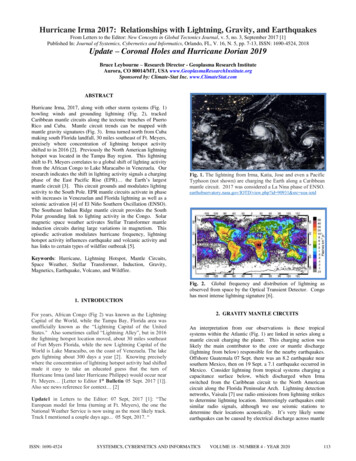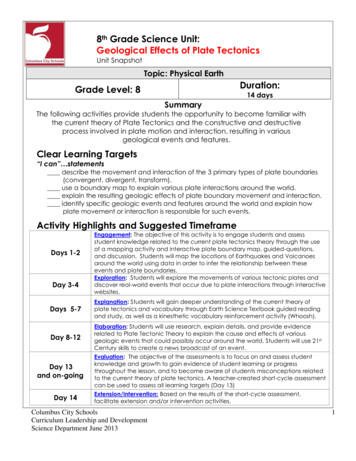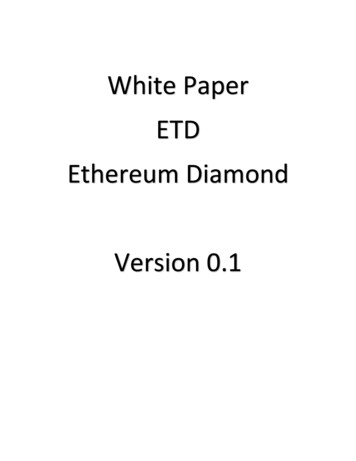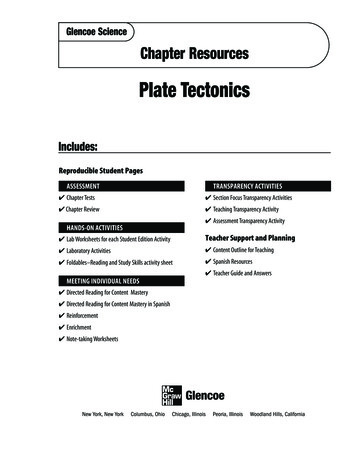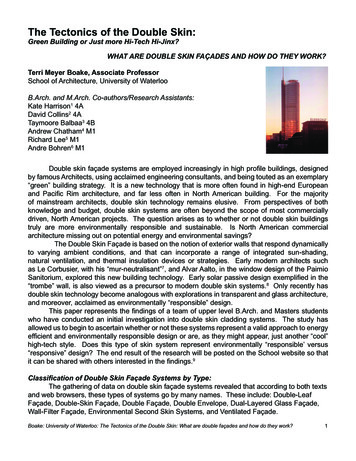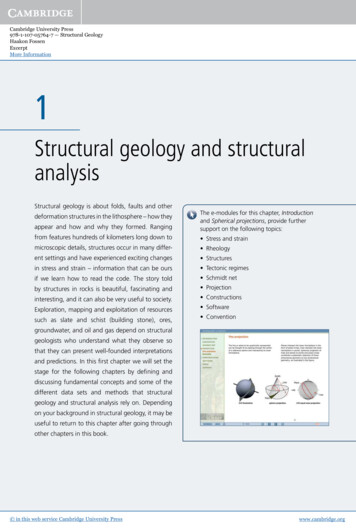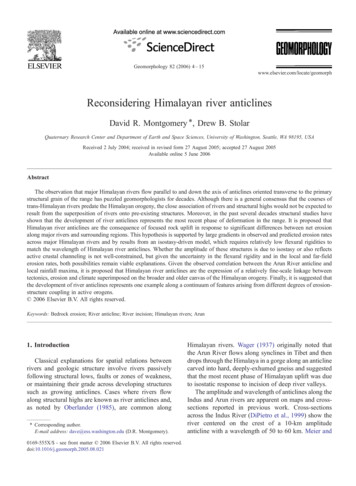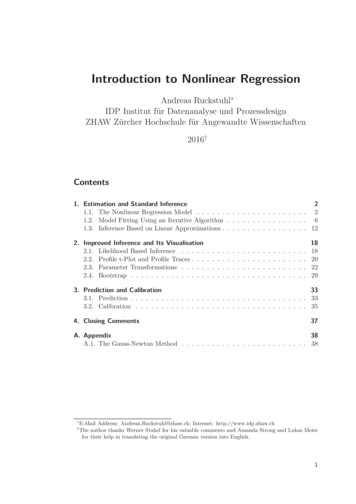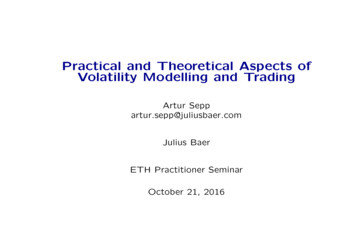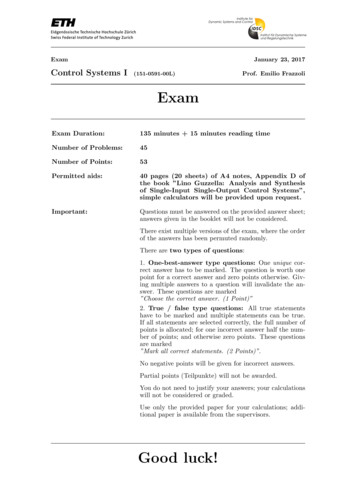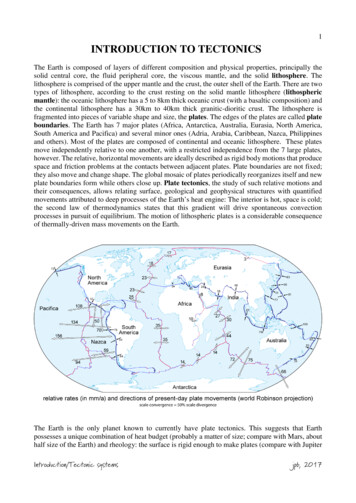
Transcription
1INTRODUCTION TO TECTONICSThe Earth is composed of layers of different composition and physical properties, principally thesolid central core, the fluid peripheral core, the viscous mantle, and the solid lithosphere. Thelithosphere is comprised of the upper mantle and the crust, the outer shell of the Earth. There are twotypes of lithosphere, according to the crust resting on the solid mantle lithosphere (lithosphericmantle): the oceanic lithosphere has a 5 to 8km thick oceanic crust (with a basaltic composition) andthe continental lithosphere has a 30km to 40km thick granitic-dioritic crust. The lithosphere isfragmented into pieces of variable shape and size, the plates. The edges of the plates are called plateboundaries. The Earth has 7 major plates (Africa, Antarctica, Australia, Eurasia, North America,South America and Pacifica) and several minor ones (Adria, Arabia, Caribbean, Nazca, Philippinesand others). Most of the plates are composed of continental and oceanic lithosphere. These platesmove independently relative to one another, with a restricted independence from the 7 large plates,however. The relative, horizontal movements are ideally described as rigid body motions that producespace and friction problems at the contacts between adjacent plates. Plate boundaries are not fixed;they also move and change shape. The global mosaic of plates periodically reorganizes itself and newplate boundaries form while others close up. Plate tectonics, the study of such relative motions andtheir consequences, allows relating surface, geological and geophysical structures with quantifiedmovements attributed to deep processes of the Earth’s heat engine: The interior is hot, space is cold;the second law of thermodynamics states that this gradient will drive spontaneous convectionprocesses in pursuit of equilibrium. The motion of lithospheric plates is a considerable consequenceof thermally-driven mass movements on the Earth.The Earth is the only planet known to currently have plate tectonics. This suggests that Earthpossesses a unique combination of heat budget (probably a matter of size; compare with Mars, abouthalf size of the Earth) and rheology: the surface is rigid enough to make plates (compare with JupiterIntroduction/Tectonic systemsjpb, 2017
2made up almost entirely of gases) but weak enough to localize strain (compare with Venus, similarsize and composition as Earth, but possibly stronger lithosphere).Geodynamics is the discipline of Earth Sciences that attempts to explain observations about therecent large-scale features of the globe in terms of mechanical (dynamic) principles. It becomesaccepted that repeated amalgamation and subsequent breakup of continental lithosphere along withrepeated creation and subduction of oceanic lithosphere have profoundly affected Earth’s evolutionsince the Archaean. In this plate-tectonic framework, large-scale deformation is the local response ofthe lithosphere to induced stresses.Plate relative motionsThe large-scale features of the Earth are geographic (map distribution and topography) and resultfrom both horizontal movements that may reach up to 20 cm/year and vertical components of up to10 mm/year. This is an order of magnitude difference. This is why also, on a structural / geodynamicpoint of view, the horizontal, relative movements between plates (as fast as nails grow!) will dominatethe structures of interest to geologists, keeping in mind that at some stage (an order of magnitudeless) vertical movements will also have to be taken into consideration.Plates may:- move apart (divergent boundaries),- glide horizontally along each other (wrench and transform boundaries) or- move toward one another (convergent boundaries).These relative plate movements may combine in varying degrees, depending on the overall plateinteractions. An oblique convergence of plates produces transpressive deformation. An obliquedivergence produces transtension. The descent of one plate beneath the other and deep into theasthenosphere is the most common response to the space problem posed by convergence.On the present earth, the plate organization has formed two networks: (1) an about 70000 km longchain of divergent boundaries and (2) an about as long chain of convergent boundaries. Both aresegmented and connected by strike slip boundaries. This simple organization results from the patternsof plate motions and mantle convection, which are stable on a long term. In fact, the stresses thatdrive lithospheric motion arise from two sources:Introduction/Tectonic systemsjpb, 2017
3(1) gravity acting on density variations within the lithosphere(2) gravity acting on density variations deeper than the lithosphere.The latter gives rise to tractions (radial and tangential) that act on the base of the lithosphere, affectingthe stress field of the lithosphere and producing dynamic topography. The former involves densityvariations associated with support of non-dynamic components of topography.Structure systemsA system is a group of individual yet interdependent components that interact to form a unified entityand are under the influence of related forces. Systems have real or arbitrary boundaries. Any changein a system occurs in order to maintain equilibrium, which is the condition of the lowest possibleenergy. Equilibrium is also the condition in which the net result of the forces acting on the system iszero.A geologic system is a group of related natural features, objects and forces that can be isolatedcompletely and arbitrarily from the rest for consideration of the changes that may occur within itunder varied conditions until equilibrium is reached. Geologic systems may be short-lived or maypersist over millions of years.Two types of systems are important in geology.- closed systems exchange only heat with their surroundings (e.g. a cooling lava flow).- open systems can exchange heat and matter (e.g. a hydrologic system that can receive rainsand loose flowing water).Most geologic systems are open systems in which energy and material are rearranged towards a stateof equilibrium. Therefore, these changes occur in a predictable (i.e. systematic) way. Because allcomponents are interconnected, any small change in any component causes change in the rest of thesystem. Predicting and understanding these changes is the key to understanding natural geologicallaws.A major geological system is the tectonic system that involves the movement of lithospheric plates.The plates move seemingly independently, which indicates that the system is dynamic, i.e. materialand energy move and change from one form to another. Regional stresses in lithospheres generateparticular deformation subsystems with characteristic geometry, attitudes and organisation, inparticular at plate boundaries. Six fundamental structure subsystems (3 end members and 3intermediate) are identified:End member tectonic subsystemsIntermediate tectonic subsystemsCompressive systemExtension systemStrike-slip systemTranspression systemTranstension systemSyn-convergence extension systemsThese subsystems, which contain structures of the same geological age, in response to the sametectonic processes, may cover enormous regions, e.g. 10 to 100 km in width for some 1000 km inlength in orogens or passive margins.One can understand the relationship between these structure subsystems with a simple model, takingthe round cover of a bin as a plate. It is strong and rigid. Place all around the bin-cover sand, whichrepresents the weak ranges and/or sedimentary basins. Sand reacts to stress in a brittle manner likeupper crustal rocks. What happens in sand when moving the bin cover?(1) A brittle compression system with thrusts develops in front of this experimental plate.(2) A brittle extension system with normal faults develops behind the plate.(3) Strike-slip systems develop on both sides of the bin cover, one clockwise (dextral) and theother anticlockwise (sinistral).Introduction/Tectonic systemsjpb, 2017
4In this experimental approach one considers only horizontal deformation components. Regional-scaledeformation may also be associated with vertical mass transfers such as anatectic and plutonic domes.Such regional systems are usually controlled by gravity-dominated forces and produce structurescomparable to those formed in the compression, extension and strike-slip systems.Tectonic regime - Fault systemsRegional stress fields control active fault systems. One assumes a Cartesian system of coordinateaxes parallel to the principal stresses σ1 , σ2 and σ3 , with the ( x, y ) plane horizontal. Any of theprincipal stresses can be vertical. This vertical component σzz is the overburden i.e. the lithostaticpressure:σzz ρgzwith ρ the average density of the overlying rocks, z the depth and g the gravitational acceleration.There is no tectonic contribution (deviatoric stress) in the vertical direction.Introduction/Tectonic systemsjpb, 2017
5Compression – Thrust systemsUpward movement of the hanging wall on a thrust fault indicates that the compressional deviatoricstress σii is applied in one horizontal direction (for instance x) and exceeds the smallest principalstress component, which is vertical while the intermediate principal stress is large enough to containdeformation. The horizontal compressional stress is:σ1 ρgz σ xx σ xxAssuming elastic deformation and no strain in the intermediate y-direction, (in this case parallel toσ 2 ), the Poisson ratio ν (defined in the Rheology chapter) relates the deviatoric stress component σ yy to σ xx : σ yy ν . σ xxThe horizontal principal stress σ 2 parallel to y is therefore:σ2 ρgz ν. σ xxThe general, triaxial tectonic condition σ1 σ 2 σ 3 becomes:( ρgz σxx ) ( ρgz ν. σxx ) ρgzwith all principal stresses positive in compression; the vertical, least compressive stress is σ3 .Conjugate thrusts dip 30 .Introduction/Tectonic systemsjpb, 2017
6Extension – Normal fault systemsHorizontal extension on normal faults implies that the smallest deviatoric stress σii is applied inone horizontal direction (for instance x). Since this direction is tensional: σ xx 0The horizontal principal stresses are expressed in the same way as for thrusting:σ3 ρgz σ xx σ xxσ2 ρgz ν ( σ xx )The condition σ1 σ 2 σ 3 becomes:( ρgz σxx ) ( ρgz ν. σxx ) ρgzThe vertical stress is the most compressive stress σ1 . Note that the deviatoric σ xx remains smallerthan overburden and σ3 remains positive. Conjugate normal faults dip 60 .Transcurrent tectonics - Strike slip systemsStrike slip faulting describes horizontal displacements. Following the same reasoning as forcompression and extension, the vertical direction z is the no strain, intermediate stress axis σ2 (theno-strain direction). The horizontal deviatoric stresses are compressive in one direction and tensionalin the other. σ xx 0Eitherand σ yy 0 σ xx 0orand σ yy 0One is larger than the lithostatic pressure while the other is smaller.The condition σ1 σ 2 σ 3 becomes:( ρ gz σxx ) ρ gz ( ρ gz ν. σxx )Conjugate faults intersect along the vertical σ2 axis, which implies that strike slip faults are vertical.Mantle dynamicsThe Earth is a heat engine through radioactive decay, primordial heat, latent heat of crystallizationand tidal heating. Heat flow drives internal convection in the liquid outer core and the asthenosphere.Conduction of heat occurs through the lithosphere. Earth’s cooling and the associated mantleconvection provide the main energy that maintains the tectonic engine. Creation (freezing) andsubduction (sinking and melting) of the oceanic lithosphere vitally contribute to mantle convection.The relationship of plates with the underlying mantle largely controls whether they approach orseparate.MantleThe mantle is embedded between the lithosphere and the core. The mantle itself is subdivided intothe upper and lower mantle (asthenosphere and mesosphere, respectively), with the transition zonelocated at a depth of ca. 670 km. This seismically reflective boundary is attributed to changes indensity and viscosity subsequent to compositional and mineral changes, the lower mantle havinghigher density and viscosity because the extremely high pressure at this depth tightens the atomicpacking of crystalline structures.The mobility of the lithospheric plates is a surface manifestation of larger and deeper movements inthe mantle. Energy considerations based on measurements of heat flow and the amount (andIntroduction/Tectonic systemsjpb, 2017
7disintegration) of radioactive elements in mantle rocks lead to theoretical estimates of enoughenergy to generate whole mantle convection.Seismic tomographic images and progress in numerical modelling suggest that three modes of flowdominate the structure of the Earth's mantle: (1) Subducting plates, some of which penetrating intothe deeper lower mantle (e.g. Circum-Pacific region), attest for descending currents; (2) Large-scale,broad upwelling-plumes like beneath mid oceanic ridges (e.g. South Pacific), attesting for ascendingcurrents; (3) Small-scale upwelling-plumes.Continents move, ridges and subduction zones move or disappear. Therefore, the distribution ofconvection cells varies with time, which implies that mantle convection is not-stationary.Hot-spot reference frame: Westward drift of the lithosphereHot spots are stationary, intraplate and long-lived volcanic centres whose origins were speculated tobe in particularly hot source regions, deep in the mantle. Their surface traces are long, narrow, timeprogressive volcanic chains used to infer that the lithosphere is moving on top of such spatiallyrestricted and supposedly fixed sources, which deliver magma through rising plumes. Plumes areconsidered to be heat- and melt-transporting columnar diapirs rising from the core–mantle boundarybecause of their thermal buoyancy.Hot spots are independent of, and usually remote from plate boundaries. However they are animportant element of mantle convection. About 10% of heat flow across the mantle is apparentlycarried by plumes, which are driven by basal heating rather than surface cooling and subduction ofcold lithosphere. The related, volcanic centers have huge lava production rates and provide areference point for anchoring measurements of plate kinematics, provided the hotspots are maintainedover sufficiently long times. If hot spots are relatively fixed and nearly punctual surface terminationsof narrow plumes, then they constitute a framework for calculation of absolute plate motions. On thebasis of such a hot-spot reference frame, an average 50 mm.a–1 westward drift of the lithosphererelative to the asthenospheric mantle has been assessed. This drift is an average delay of thelithosphere with respect to the hot spots but, conversely, is also a relative eastward flow of theasthenosphere with respect to the lithosphere. The Earth’s rotation may contribute to this bulk flow(the asthenospheric “wind”) and mantle dynamics.Introduction/Tectonic systemsjpb, 2017
8Westward drift implies that plates have a general sense of motion, and are not moving randomly.Geophysical and geodetic analyses suggest that plates move along sinusoidal flow lines with differentvelocities, yet with the general westward direction. Therefore plates are more or less mechanicallydetached from the mantle.Introduction/Tectonic systemsjpb, 2017
9The degree of decoupling is controlled by lithospheric thickness and composition, and/or thethickness and viscosity of the underlying asthenosphere, and the lateral variations of these parameters.Where a plate moves faster toward west than its adjacent plate behind, to the east, the plate margin isdivergent; conversely, if this plate moves faster to the west than its preceding plate, to the west, theirboundary is convergent.The lithosphere delay with respect to the mantle may create strong structural asymmetries insubduction and rift zones. The asthenospheric flow may influence steepening or shallowing of slabs:- the slab will steepen where it is oriented against the asthenospheric wind, which pushes theslab upper boundary;- the slab will become shallower where it is supported by the asthenospheric wind, whichopposes the slab pull by pushing on the slab lower boundary.However, there is an apparent contradiction between the idea of hot spot fixity (their motion at thesurface is negligible compared to plate motions) and their proposed plume origin implying active,dynamic mantle convection. In fact, the on-going recognition of hot spot mobility and that some hotspots are linked to shallow plumes leads to new absolute reference frames such as GPS data.Fate of slabs and other deep processesSubduction describes how a part of the lithosphere, the slab, plunges and falls down into the mantle.Slabs have a wide range in material age, thickness and density. They therefore reach a position ofneutral buoyancy at different depths. Old, cold slabs are likely to sink deeper than younger andwarmer slabs. Whatever their age, slabs are cold where they enter the asthenosphere but immediatelybegin being warmed up from both sides towards temperatures of the surrounding mantle. Sediments,crustal lavas and magmatic rocks and the subducted mantle reach at some depth their meltingtemperature. Dehydration, melting and recycling through the mantle, and their contribution to mantleheterogeneity are likely different. Melting and recycling are considered to be responsible for hotspotand island arc volcanism.The geological information yields a mean life span of 2Ga for the continental crust, only less than185 Ma for the oceanic crust. This significant discrepancy is taken as evidence that the continentalcrust tends to avoid recycling in subduction. Taken in the same reference frame, subducting platesmove 3-4 times faster than their overriding plates. This difference is likely caused by slab pull, givingfurther evidence that body forces are important and that the lithosphere is part of the actors thatanimate plate tectonics.Introduction/Tectonic systemsjpb, 2017
10RollbackWhen the negatively buoyant slab (compared to the asthenosphere) is long and heavy, or anchored inthe mantle, it can sink more rapidly than the rate of plate convergence. The gravitationally unstableslab becomes steeper, which produces a migration of the hinge zone and the bulge, where the slabbends, away from the arc. Rollback describes the oceanward retreat of the trench due to thegravitational pull of the slab. Slab rollback and consequent trench retreat play two important roles:(1) It inserts extensional episodes in an overall convergent regime and (2) it triggers changes in plateboundary patterns.Syn-convergence extensionThe asthenosphere of the overriding plate must flow towards the retreating slab to compensate thespace left by the slab that sweeps back through the mantle like a paddle.This passive flow produces a suction force that pulls the overriding plate, where it induces extension.Accelerated rollback may thus produce a switch from compression to extension tectonic modes in anoverall convergent setting (back-arc extension is a classic example). The overriding plate tends tosplit at the active arc, while the forearc tends to adhere to the migrating trench. Indeed, the strengthof the hanging wall plate is smallest at the arc, due to thermal weakening and high potential energyin the thicker arc crust.Rollback is particularly evident for west-directed subduction zones such as the Marianas, Barbados,and the Apennines, where it is associated with back-arc opening.Toroidal flowObviously, the asthenosphere below the rolling-back slab has to flow out of the way. This may beaccomplished by along strike flow and evacuation around the slab edges or through slab windows (agap opened in the slab). Toroidal flow describes the swirling transfer of mantle material from belowto above the slab region.Introduction/Tectonic systemsjpb, 2017
11Realignment of plate boundariesRollback is essential in changing the orientation of plate boundaries. Paleomagnetic measurementson the Fiji Islands show that the latter have rotated by 90 over the last 40 Ma, which implies that thetrench line near the Tonga-Kermadec arc has pivoted by about the same angle about the North Islandof New-Zealand. Such rotations suggest that rollback is effective between a rotation axis and a tearfault in the slab. The process might be able to generate curved orogens.Introduction/Tectonic systemsjpb, 2017
12Slab fragmentationAfter long convergence, the slab can be long enough to reach a weight larger than the lithospherictensile strength. The slab breaks where the tensile strength is reached and slab segments separate fromthe buoyant part of the lithosphere at the surface. Then these slab segments sink more rapidly andcome to float within the asthenosphere where they eventually dissolve thermally and becomegradually absorbed. Gaps in earthquake distribution along slabs were taken as evidence for slabrupture. Seismic and tomographic information documents two major ways slabs can break: alongnearly horizontal tears and along down-dip tears.Slab break-offThe slab (usually oceanic lithosphere) can detach from the surface (often continental) part of the platealong a fracture propagating horizontally, along-strike of the trench, probably after and along neckingof the descending lithosphere. This event is known as slab break-off, which has severe consequencesfor the development of collisional zones.With slab break-off there is cessation of slab pull. Termination of this downward force brings abouta general uplift of the collision zone due to both the elastic unbending of the subducting plate andisostatic rebound of the buoyant thickened crust. Asthenospheric material replaces the dense slaband elevates the heat flow, which may lead to partial melting of both the mantle and crustal materialand produce voluminous magmatism and volcanism. These processes have been proposed to accountfor the Late Eocene - Oligocene magmatism in the Alps (Periadriatic intrusions, Adamello, Bergell).Slab vertical tearVertical tear of slabs (mostly oceanic lithosphere) likely occurs along fracture zones (ancienttransform faults?) and might be due to horizontal extension required by the arcuate shape ofsubducting slabs, which creates some sort of divergence at depth. Asthenospheric toroidal flow mayaccommodate further slab rollback if the slab is still attached to the plate.Introduction/Tectonic systemsjpb, 2017
13Slab fragmentationCombined horizontal and vertical fracturing produces extensive slab fragmentation intodisconnecting pieces of variable sizes.Subduction flipIf an oceanic plate overrides a continental lithosphere, the less dense continental material resists tosinking. Slab breakoff and subsequent isostatic rebound of the previously subducted continent mayinduce the sense of subduction to be reversed so that the previously upper plate becomes thesubducting one. Subduction is flipped. After break-off or flip, the abandoned slab is absorbed intothe asthenosphere. This could explain why most ocean trenches are found along the edges ofcontinents.Introduction/Tectonic systemsjpb, 2017
14Removal of the lithospheric mantleThe mantle lithosphere has higher density than both the overlying crust and underlying fluidasthenosphere. Therefore the buoyancy of the 5-8 km thick oceanic crust compensates no more thana 35-56 km thick mantle lithosphere. Similarly the 30-40km thick continental crust does notcompensate more than 250 km of mantle lithosphere to float on the asthenosphere. The mantlelithosphere is therefore an unstable layer in the plate construction. It does not sink because the positivebuoyancy of the crust holds it up unless the bonds between crust and mantle are broken. Four mainmechanisms have been envisioned to remove continental lithospheric mantle (i.e. ungluing the crustfrom its mantle lithosphere):(1) mantle subduction,(2) delamination(3) convective thinning,(4) foundering of dense layers.In all cases, the asthenosphere flows to replace lithosphere.Exercise:Calculate and plot the crustal thickness / mantle lithosphere thickness required forneutral buoyancyMantle subductionMantle subduction is assumed to follow an earlier subduction of oceanic lithosphere. The overlyinglithosphere acts as a wedge-shaped scraper that splits the subducting lithosphere. The crust is shearedoff the mantle lithosphere at a point of discontinuity (called singular point). The lithospheric mantlecarrying no more crust sinks into the less-dense asthenosphere while a crustal sheet (flake) of thesplit lithosphere may override the other lithosphere. Flake tectonics refers to this collision process.Introduction/Tectonic systemsjpb, 2017
15DelaminationDelamination is a generic term for separation of two initially bonded layers. Tectonic delaminationis favoured by the presence of relatively weak crustal layers provided by major changes incomposition and thus rheology.Introduction/Tectonic systemsjpb, 2017
16Earth scientists have envisioned two possibilities: layer division and convective thinning. In bothcases, the asthenosphere flows to replace the lithosphere. Subsequent heating may cause partialmelting and magma generation. Magma may intrude the upper crust as post-orogenic plutons. Inaddition, the hot asthenosphere replacing the heaviest lithosphere triggers isostatic uplift.Geographical and time propagation of magmatism and uplift might help differentiating thesedelamination modes.Layer separationDense crustal and/or mantle layers are ripped away from the layers atop. The negatively buoyant,detached layers or portions of dense layers sink into the deeper mantle and asthenosphere. Whilemantle lithosphere progressively peels away from crust as a coherent sheet, the delamination pointmigrates away from its starting point and the region of thinned lithosphere enlarges. Hotasthenosphere invades the gap as it opens between the descending mantle and the crust.Convective thinningLithospheric shortening in orogenic belts is isostatically accommodated by the formation of a thicklithospheric root. Convective thinning is then driven by the negative buoyancy of the mantlelithosphere thickened by shortening. The mantle lithosphere from adjoining regions flows into thedownwelling as this Rayleigh-Taylor instability grows. Eventually, upwelling asthenosphere replacesthe mantle lithosphere as it is thinned and stretched. The downwelling lithosphere drops into theasthenosphere, which substantially increases the gravitational potential energy of the overlyingcontinental crust. Conductive warming reduces the strength of the orogen. As a result the orogen maybe thrown into extension, as the isostatically uplifted crust attempts to spread laterally (postcollisional collapse of orogens).Thermal erosionThe boundary between lithosphere and asthenosphere is thermally controlled, since it is the samematerial (peridotite) in solid and liquid forms. Convective thinning occurs as heat is advected to thebase of the lithosphere at a rate larger than normal basal flux, and conducted within the lithosphere.Convection in the liquid asthenosphere is a process of heat transfer much more efficient thanconduction in the solid shell. In that case, temperature is increased and the melting point can beexceeded at the bottom of the mantle lithosphere. Then the mantle lithosphere thins down as it istransformed into asthenosphere.The heat excess can be carried to the lithosphere by mantle plumes that cause the lithosphere to thinwith isotherms progressively rising through. Uplift in large swells is due to thermal expansion morethan dynamic overpressure of the impinging plume. Delamination could start once the asthenospherehas cut the mantle lithosphere and reached the crust.Introduction/Tectonic systemsjpb, 2017
17Foundering of dense layersDense mafic/ultramafic layers of the crust and portions of mantle lithosphere fall down as viscouschunks into the less dense asthenosphere. The upwelling asthenosphere replaces the removedlithospheric pieces but the region of thinned lithosphere keeps the same size and areal limits as at thedivision time.Slab graveyardSeismic observations show a shear velocity discontinuity and a density jump at 660 km depth andseveral slow anomalies just underneath. This seismic discontinuity is the boundary between the upperand the lower mantle and is attributed to a phase change from spinel at low pressure to much stifferperovskite at higher pressure. Earthquakes occur all the way down to this boundary, but not below.The seismic tomography supportively images lithospheric slabs subducting through the upper mantle.They are either deflected along the upper-mantle/lower-mantle transition zone and/or penetrate intothe lower-mantle down to the core-mantle boundary. Tomographic results suggest piling of giganticrecumbent folds laying at this boundary, similar to buckles of honey poured on a slice of bread (e.g.beneath the Caribbean). Laying (stagnant) slabs and buckle folds both indicate that subductedlithosphere experiences resistance to further penetration when they encounter the 660 km deepdiscontinuity.The lowermost lower mantle, known as the D”-layer (depth between ca 2700 and 2900 km), has beenpostulated to be the ultimate destination of slabs. This layer may reflect a change in mineral structurefrom the relatively low-temperature magnesium silicate perovskite to a post-perovskite form at thecore-mantle boundary. High seismic velocities and reflections from just above the anomalously highwave speed core image relatively cold slab material laying and accumulated on the core-mantleboundary but the evidence is disputed.Introduction/Tectonic systemsjpb, 2017
18Slow melting of slab material may source plumes from both "graveyard" levels, the core-mantleboundary and the 660km discontinuity. Thus, the
chain of divergent boundaries and (2) an about as long chain of convergent boundaries. Both are segmented and connected by strike slip boundaries. This simple organization results from the patterns of plate motions and mantle convection, which are stable on a long term. In fact, the stresses that drive lithospheric motion arise from two sources:
